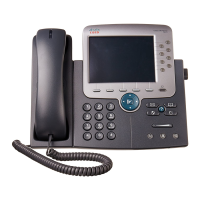Step 7
Request the ITL file.
The phone requests the ITL file after it requests the CTL file. The ITL file contains the certificates of the
entities that the phone can trust. The certificates are used to authenticate a secure connection with the servers
or to authenticate a digital signature that the servers sign.
See the Cisco Unified Communications Manager Security Guide, “Security by Default” chapter.
Step 8
Request the Configuration File.
The TFTP server has configuration files, which define parameters for connecting to Cisco
Unified Communications Manager and other information for the phone.
See Phone Configuration Files, on page 34 and Startup Problems, on page 215.
Step 9
Contact Cisco Unified Communications Manager.
The configuration file defines how the Cisco Unified IP Phone communicates with Cisco
Unified Communications Manager and provides a phone with the load ID. After the phone obtains the file
from the TFTP server, the phone attempts to make a connection to the highest priority Cisco
Unified Communications Manager on the list. If the security profile of the phone is configured for secure
signaling (encrypted or authenticated), and Cisco Unified Communications Manager is set to secure mode,
the phone makes a TLS connection. Otherwise, it makes a nonsecure TCP connection.
If the phone was manually added to the database, Cisco Unified Communications Manager identifies the
phone. If the phone was not manually added to the database and autoregistration is enabled in Cisco
Unified Communications Manager, the phone attempts to autoregister in the Cisco Unified Communications
Manager database.
Autoregistration is disabled when you configure the CTL client. In this case, the phone must be
manually added to the Cisco Unified Communications Manager database.
Note
See Phone Configuration Files, on page 34 and Startup Problems, on page 215.
Cisco Unified Communications Manager Phone Addition
Methods
Before you install the Cisco Unified IP Phone, you must choose a method for adding phones to the
Cisco Unified Communications Manager database.
The following table provides an overview of the methods for adding phones to the
Cisco Unified Communications Manager database.
Table 9: Cisco Unified Communications Manager Phone Addition Methods
NotesRequires MAC address?Method
Results in automatic assignment of
directory numbers.
Not available when security or encryption
is enabled.
NoAutoregistration
Cisco Unified IP Phone 7975G, 7971G-GE, 7970G, 7965G, and 7945G Administration Guide for Cisco Unified
Communications Manager 9.0 (SCCP and SIP)
37
Cisco Unified IP Phones and Telephony Networks
Cisco Unified Communications Manager Phone Addition Methods

